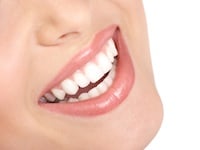Teeth Straightening

- Cost: £1000 - £8000 depending on the system & practitioner
- Treatment length: 8 weeks to 4 years depending on condition
- Used for: crooked teeth, gaps, twisted teeth, over- & under-bites
- Available: From most cosmetic dentists
Table of contents
Why teeth straightening?
Many people are born with crooked teeth. In some cases, perfectly straight teeth can become crooked with age, as the structure of your mouth changes, or due to tooth loss and movement of the remaining teeth.
Teeth straightening can be achieved by a variety of different cosmetic dental techniques. Not everyone needs to have fixed wire braces or wear unsightly headgear for a perfectly aligned smile.
Fixed orthodontic braces
Orthodontic braces are the traditional way that teeth are straightened and are typically associated with young children. Metal wires are attached to the front surfaces of your teeth with brackets. These brackets and wires are progressively tightened over time, applying gentle pressure to the teeth and encouraging them to move into a straighter position. The time taken depends upon how much movement of your teeth is required, and your orthodontist or dentist will be able to advise you following an initial examination. A wide variety of brackets and braces systems is now available, including smaller tooth-coloured ceramic brackets and friction-free braces such as the Damon system.
Lingual braces
Lingual braces are similar to standard wire braces but they are fitted to the inside (back) surfaces of your teeth and so are not visible from the front. They can be quite uncomfortable and difficult to get accustomed to but provide a perfect solution to straightening your teeth without anyone noticing. Unlike invisible braces, they can even be used to correct severe orthodontic cases.
Invisalign
The Invisalign system aims to achieve perfect teeth-straightening results without the need for visible wires, which can be a source of embarrassment for some people. Using a system of clear aligners that look like transparent gum shields, your teeth are slowly moved into their desired position. The aligners are changed every two weeks. The advantage of Invisalign over metal braces is that you can remove them to clean your teeth and eat. Invisalign is an increasing popular treatment for the straightening of adult teeth.
Inman Aligner
The Inman Aligner is a cross between the invisible braces system and a metal braces system, as it is not as "invisible" as Invisalign (since it has metal components) but it relies on a removable aligner that moves the teeth by applying force to them over time. The Inman Aligner is often quicker than Invisalign, only one appliance is required for the entire treatment, and it is more affordable. To read more about the Inman Aligner, click here.
Damon Braces
Damon Braces are a "friction-free" alternative to conventional treatment with braces. The do not have any elastic ties and so cause less irritation, are more comfortable and provide faster tooth-straightening results than treatment with conventional braces. To read more about Damon Braces, click here.
Six-Month Smile
The Six-Month Smile is a new orthodontic treatment uses tooth-coloured brackets and wires and focuses on moving the teeth that you see when you smile (rather than focusing on the bite and moving all the teeth). It uses special nickel wires to move the teeth into the desired position. Treatments that would usually take 18 months to two years are completed in as little as six months.
Porcelain veneers
Porcelain veneers do not actually straighten your teeth, but give the illusion of a perfectly aligned smile. Provided that your teeth are not severely crooked, porcelain veneers can be placed over the front surfaces of your teeth to make them look straight. Veneers are sometimes referred to as “instant orthodontics” because straight teeth can be achieved in as little as a single visit to the dentist (compared to traditional braces or Invisalign, which can take many months, and in some cases, a couple of years). The added benefit of veneers is that they can also improve the colour and shape of your teeth. The downside is that some of your naturally healthy tooth structure needs to be removed for the veneer to affix to; veneers also do not last forever and will eventually need replacing. To read more about porcelain veneers, click here.









